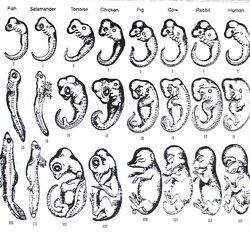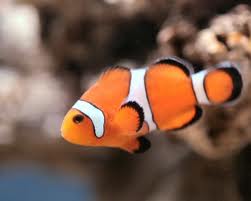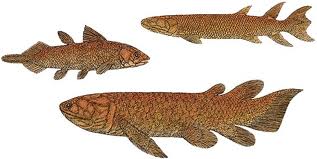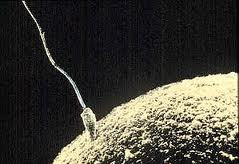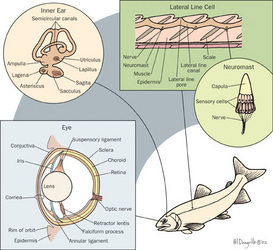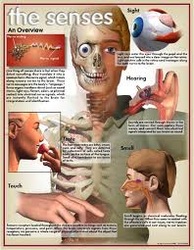We're Not Favored, Just Lucky
For many years, humans considered themselves favored by a God who created each creature in a static hierarchy, with human beings dominating the pinnacle, being created in the perfect image of their creator. After Charles Darwin developed the Theory of Evolution, scientists began tracing the ancestry of human beings and discovered some very shocking evidence: humans are actually descended from fish! This page hopes to explore the links between humans and fish to demonstrate the importance of descent with modification, and how the basic design of the fish evolved into the image of humanity.
Dem Bones Dem Bones, They Walk Around...
If fish are the ancestors to you and me, how did we ever develop feet, much less move onto land?
- The lobe-finned fish shares the same basic skeletal structure as human beings do, as evidenced when comparing their anatomical features. Examining the fin of the lobe-finned fish, one can see that inside the fleshy fin that helps guide and propel the fish through the water, all the bones of the human arm exist: The humerus, the ulna and radius, and the multiple bones that make up the wrist and hand in humans. These features originate in the fish' s paddle-like structure.
- As the lobe-finned fish underwent descent with modification, the operculum, the bony covering that protects the gills in all bony fish, began to shrink, eventually disappearaning, allowing for a wider range of motion between the head and body of the animal, eventually developing into the strong neck of humans. This adaptation allowed the fish to come up for air and fill its lungs with oxygen.
- Until the evolution of Tiktaalik, fish did not have ribs, a common characteristic of all tetrapods, including humans
- Humans and fish share similar skull structures
- The labyrinthodont tooth connects the lobe-finned fish to amphibians, which gave rise to reptiles, which eventually gave rise to mammals, or us!
- Gill arches in fish evolved into the jaw, ears, larynx and throat of humans
Inside the Fish: Cells and Chemistry
Cell and development structure link humans to our fish ancestors:
- Comparative embryology shows that humans, and all tetrapods, retain the basic chordata features of gill slits, a notochord, and a dorsal nerve cord, linking humans to fish
- All tetrapods contain the same hox genes, but different hox genes are expressed in different amounts in each organism, creating a unique species; however, because the same hox genes exist in both humans and fish, the two groups are related
- Cells develop the same way in humans as they do in fish: the blastopore becomes an anus, rather than a mouth, indicating that both fish and humans are deuterostomes
From Fins to Bipedal

As we all know, fish, like the Little Mermaid, live under the sea; however, rather than finding an evil sea-witch to magically transform fins into a pair of legs, ankles, and feet that allow us to walk upright, nature again selected for characteristics through time that led to the bipedal stance - or ability to maneuver on two limbs. This section traces the transformation from fintastic to land dwelling biped.
- Primeval body plan designed to increase mobility in water: streamlined body shape with caudal fin for propulsion and pectoral and pelvic fins for balance
- The pectoral and pelvic fins develop over time in lobe-finned fish to become fleshy structures supported by the "arm" bones found in humans
- Eusthenopteron was "the fish with legs"
- Tiktaalik had a developed pectoral girdle and strong lobes, enabling it to lift itself out of the water to breath air, increasing his oxygen content
- Acanthostega was the first amphibian, categorized as such because it had 8 independent digits on each limb (formerly the lobe); it was aquatic, and used its limbs for walking on the bottom of his aquatic environment
- Amphibians provide an example of the "spread stance," where the limbs protruce from the pectoral and pelvic girdles without having the ability to bend into a semi-erect stance
- Some reptiles, such as the alligator, display the semi-erect stance, and were part of the crocodilian clade descended from Thecodonts
- Archeosaurs and Therapsids displayed the erect stance, enabled by the construction of their wrist and ankle, where all four limbs were located directly under the body of the reptile
- Two types of erect stances exist: quadrapedal (stance involving four limbs) and bipedal (stance involving the two limbs attached to the pelvis)
- Descended from Therapsids, mammals inherited the upright stance, and over time , the ancestors of humans developed bipedalism, a trait that had evolved earlier in dinosaurs, indicating convergent evolution
Sex is Good
Both fish and humans reproduce sexually, increasing genetic variation in each generation, allowing evolution to occur fairly rapidly. However, differences exist between reproduction strategies of fish and humans, such as:
- Fish demonstrate external fertilization of eggs, while fertilization occurs internally in humans, increasing the likelihood that an embryo will develop after sexual encounters
- Fish females produce thousands of eggs, in an attempt to ensure the continuation of the species. This is necessary because the embryos must develop on their own without parental care, and therefore many embryos will be eaten, never having the chance to bolster the fish population. In contrast, human females produce a relatively small number of eggs, but because of internal fertilization and development within the womb, the probability of embryonic survival is much higher that of fish.
- Fish provide no parental care for their young, and eggs hatch as miniature adults. Humans provide an excessive amount of parental care to their young, allowing their children to learn survival skills before abandoning them. Because human embryos develop inside the mother, who gives live birth to her children, human babies are not fully developed at birth, thus they require a suckling period to grow and gain strength, completely dependent on their mothers
- Fish testes are located near the heart in a primitive position; in humans, as development occurs, the testes migrate from their primitive position down to the scrotum, leaving the body wall of males weak in the groin area
Perceiving the World
Everyone knows that humans have excellent eyesight, but where did this come from? Comparing our fish ancestors to modern human beings, we can trace the evolution of the five senses, and which of those senses became more developed in humans.
- The placement of fish eyes were one either side of their round heads; Tiktaalik had eyes located on the top of its flat head so it could see above the water
- Tetrapods also had eyes at the top of their flat heads; humans have front-facing eyes that allow for increased depth perception
- Eyes evolved from little more than light receptors to our complex, camera-like eye with a lens
- Although fish have limited nasal passages compared to humans, the basic flow of molecules through nasal openings to the brain receptors are present in fish, and have become more dominant in mammals
- Our ear has developed from the gill arches of fish, becoming the jaws of amphibians and reptiles, with the reptile jaw bones finally evolving into the mammalian middle ear
- Our inner ear is the most ancient part of our ear and responsible for our heightened sense of balance; this evolved from small sensory sacs imbedded in the skin of fish that gave fish information on the change of water flow
